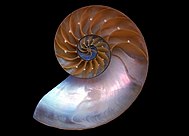Phragmocone
Right: Schematic longitudinal section through a pearl boat (♀) with soft tissue anatomy. The phragmocone is shown in shades of blue.
The cuttlebone ([ ˌfrakmoːkoːn ]; . Greek φραγμός phragmos , fence, containing ', κῶνος konos , cone'), also phragmocone called, is the chambered part of the shell of the cephalopod .
Ammonoids and Nautiloids ("Ectocochleata")
The outer shell of original cephalopods, including the recent pearl boats (Nautilidae) and the extinct ammonites , is divided into the living chamber, which contains the animal's intestinal sac and into which the rest of the soft body can be withdrawn for protection, and which is partly fluid-tight , partly gas-filled phragmocone.
The phragmocone of the pearl boats (as well as its extinct relatives, see → Nautiloideen ) and ammonites can be regarded as a basic form. It is divided into smaller chambers by chamber partitions (septa), each chamber partition being the back wall of an older living chamber. The chambers are completely traversed by a long, string-like extension of the viscera, the siphunculus or sipho . An air-like gas enriched with nitrogen and carbon dioxide or an aqueous tissue fluid can be released into the chambers via the Sipho. This serves to regulate the buoyancy , that is, the phragmocone serves as a hydrostatic apparatus . While nautiloids simply have septa curved away from the case mouth in the shape of a watch glass with a centrally running siphon, the septa of the ammonites, especially the septa of the geologically more recent forms (ammonites in the broader sense ), were complexly pleated in the contact area with the case walls (see → praised line ), and the Sipho was external ( ventral ).
Belemnoids and recent coleoids ("Endocochleata")
In the more modern cephalopods, the shell is moved inside the soft body and often largely regressed or even completely reduced.
In the fossil belemnites , the phragmocone is relatively short and forms the middle part of the elongated inner skeleton between the tongue- to rod-shaped proostracum, interpreted as a reduced living chamber, and the often massive rostrum (“thunderbolt”). The conical phragmocone is - mostly only with its tip - in the conical recess (alveolus) of the head-facing end of the rostrum, and the siphon usually runs ventrally. The structure of the spiral inner shell of the recent post squirrel ( Spirula spirula ) is reminiscent of the phragmocone of the Nautilus with simply curved septa, but with an internal siphon. The Schulpen of the recent Sepia (Sepiida) have a very narrow chamber with septa inclined to the dorsoventral and transversal plane, each chamber being divided up like a labyrinth by a multitude of short, partly strongly twisted and / or branching partition walls ("pillars"). Instead of a cord-like siphon, cuttlefish have a broad siphonal field covered by membranous tissue on the ventral side of the phragmocone, which is connected to the same tissue inside the chamber.
literature
- Wolfgang Oschmann: Life of prehistoric times: Basics of general and special paleontology. UTB Volume 4893. Haupt Verlag, Bern 2018, ISBN 978-3-8252-4893-2 , p. 228.
- Gerhard Haszprunar, Klaus-Jürgen Götting: Cephalopoda, cephalopods. S. 352–362 in: W. Westheide, R. Rieger (Ed.): Special Zoology Part 1: Protozoa and Invertebrates. 2nd Edition. Spektrum Akademischer Verlag (Elsevier), Munich 2007, ISBN 978-3-8274-1575-2 .
- René Hoffmann, Robert Lemanis, Carole Naglik, Christian Klug: Ammonoid buoyancy. P. 613–648 in: Christian Klug, Dieter Korn, Kenneth De Baets, Isabelle Kruta, Royal H. Mapes (eds.): Ammonoid Paleobiology: From anatomy to ecology. Topics in Geobiology, Volume 43.Springer, Dordrecht 2015, ISBN 978-94-017-9629-3 .
Individual evidence
- ↑ Antonio G. Checa, Julyan HE Cartwright, Isabel Sánchez-Almazo, Jose P. Andrade, Francisco Ruiz-Raya: The cuttlefish Sepia officinalis (Sepiidae, Cephalopoda) constructs cuttlebone from a liquid-crystal precursor. Scientific Reports. Vol. 5, 2015, item no. 11513, doi: 10.1038 / srep11513



